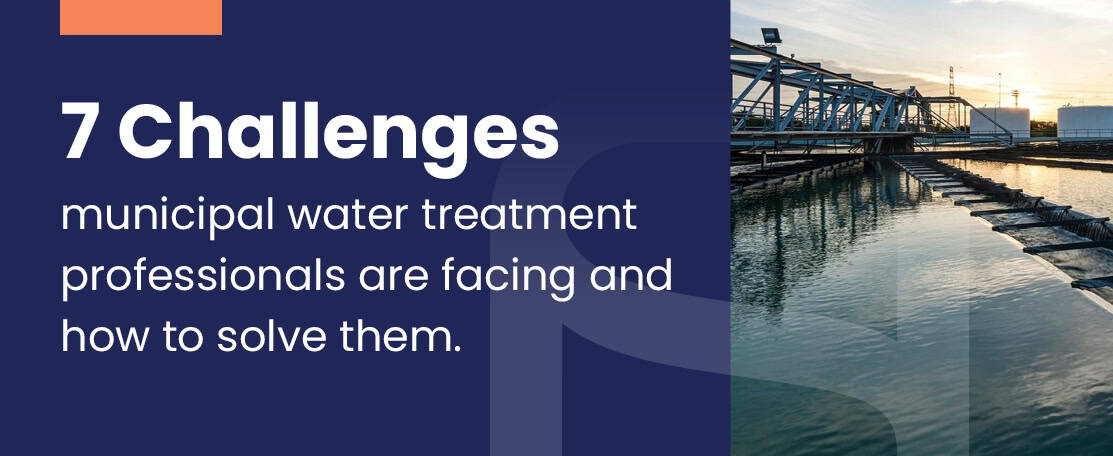
The recent ANEAS webinar on advanced UV disinfection brought together water treatment professionals from across Latin America, generating an intensive Q&A session with Shimon Constante, Atlantium’s VP of Strategic Growth. From the questions asked, seven challenges emerged that define what water treatment facilities need most: chemical-free operations, cost-competitive solutions, validated performance standards, scalable technology, strategic chemical reduction approaches, high organic load management, and advanced contamination control capabilities.
These questions show that the industry is actively seeking proven alternatives to traditional chemical-dependent processes. Here are the expert answers regarding Atlantium’s HOD™ (Hydro-Optic Disinfection) UV treatment that address these fundamental challenges.
1. Are there residual chemicals post-UV treatment?
A: No. UV treatment with Atlantium technology provides instant physical disinfection without any residual chemicals, unlike chlorine-based treatments. This is one of the fundamental advantages of UV light—it’s inherently chemical-free by nature.
When you implement our HOD UV technology, you eliminate chemical handling costs, storage requirements, and safety concerns while delivering superior disinfection performance. If your incoming water already contains chlorine, our advanced system can actually help minimize or eliminate those chlorine residuals, promoting sustainable and safe water practices.
2. In a wastewater plant that treats only municipal wastewater, is the operation cost competitive?
A: HOD UV technology typically offers highly competitive operational costs, especially when compared to chemical-based disinfection or conventional UV systems. But the real value goes beyond just comparing upfront costs.
Our systems deliver cost advantages through multiple channels: eliminated chemical purchasing and handling, reduced maintenance requirements compared to conventional UV, energy-efficient operation through our patented fiber-optic technology, and extended equipment lifespan typically exceeding 15 years.
For municipal facilities specifically, you also benefit from simplified operator training, reduced safety protocol requirements, and eliminated chemical discharge concerns. When you factor in all these operational savings compounding over time, the economics become very compelling. A detailed cost-benefit analysis for specific municipal plants requires additional information about flow rates and specific treatment conditions.
3. Which viral indicators are validated with Atlantium HOD UV?
A: Our systems have been validated using adenovirus, which is considered the most UV-resistant virus found in drinking water, achieving 4-log or greater reductions.
Adenovirus represents the worst-case scenario for UV resistance. If our technology can achieve 4-log reduction against adenovirus, you can be confident it will perform effectively against any viral contamination scenario you might encounter.
Our validation is third-party certified based on US EPA protocols, and we’re field-proven across power plants and municipal facilities. The technology also effectively inactivates protozoa such as Giardia and Cryptosporidium, providing broad-spectrum microbiological safety that regulatory bodies trust.
For wastewater applications specifically, Atlantium consistently achieves 3-log (99.9%) reductions required by standards in regions such as Brazil. If higher disinfection levels are needed, our systems can reliably achieve up to 5-log (99.999%) reductions through optimized UV dose management.
4. Can Atlantium systems provide uniform radiation at high flow rates?
A: Absolutely. This is where our patented Total Internal Reflection (TIR) technology really shines. We’ve solved the fundamental challenge that has limited UV applications in high-capacity facilities—maintaining uniform disinfection as flow rates increase.
Our system uses fiber-optic principles to trap UV light rays and force them to repeatedly bounce inside the disinfection chamber. This recycling of UV photons ensures uniform UV dose distribution even for high flows exceeding 600 liters per second.
Traditional UV systems struggle with shadow zones and uneven radiation distribution at scale. Our multi-lamp configurations guarantee no shadow zones, delivering consistent and reliable disinfection across all water volumes. This transforms UV from a capacity-limited solution to a technology that can handle municipal and industrial scale operations without performance compromises.
High turbidity can limit UV effectiveness by obstructing UV transmission. Atlantium systems manage turbidity effectively by continuously monitoring UV Transmittance (UVT) and automatically adjusting UV dose. However, pre-treatment to reduce turbidity may still be recommended for optimal performance.
5. For disinfecting drinking water, is it possible to completely replace chlorine with this HOD UV system?
A: HOD UV technology can significantly reduce or, in certain regulatory environments, completely replace chlorine for primary disinfection. However, the most successful approach is usually strategic rather than absolute.
Many regions, including Mexico, require residual chlorine presence in distribution networks to maintain microbiological safety post-treatment. The optimal strategy combines HOD UV as your primary disinfection barrier with minimal chlorine dosing for distribution network protection.
This approach can significantly reduce overall chlorine use while maintaining regulatory compliance. You get the economic and operational benefits of reduced chemical dependency while ensuring your systems meet regional requirements for distribution network safety.
6. When organic load is very high and regulations require treatment, how do you ensure effectiveness?
A: HOD UV technology can be combined with Advanced Oxidation Processes (AOP) to manage high organic loads effectively. This integrated approach is specifically designed for challenging applications where single-technology solutions fall short.
The combination ensures degradation and removal of complex organic compounds while maintaining compliance with stringent regulatory standards, regardless of how your influent quality varies throughout treatment cycles.
For more answers to your water treatment questions, visit our FAQ page!
Still curious? Our experts are just a message away
We’ve implemented this integrated treatment approach in facilities where conventional methods couldn’t handle the complexity. It transforms challenging water quality scenarios into manageable treatment processes with predictable, reliable outcomes.
7. Based on your experience with Advanced Oxidation, what contaminants can you remove?
A: AOP effectively removes challenging contaminants that conventional treatment struggles to handle, such as pharmaceutical residues, personal care products, endocrine disruptors, certain pesticides, taste and odor-causing compounds, and specific persistent organic pollutants.
This capability addresses emerging contaminants that didn’t exist when current treatment infrastructure was designed. For cutting-edge contaminants like PFAS, we’re actively developing and applying solutions that demonstrate significant removal through advanced processes.
The real value here is future-proofing. You’re not just solving today’s contamination challenges—you’re positioning your facility ahead of evolving regulations while addressing public health concerns about contamination sources that regulations haven’t caught up to yet.
For more answers to your water treatment questions, visit our FAQ page>>
Still curious? Our experts are just a message away>>







